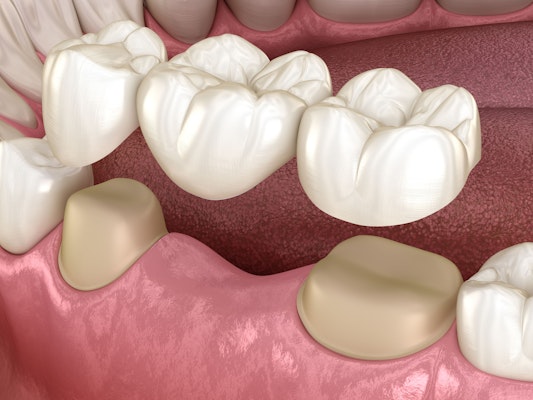Dental Bridges
Do you have a missing tooth? A dental bridge can fill the gap in your smile and restore the function of your bite.
At Nordhus Dentistry in West Wichita, we provide both traditional and implant-supported bridges that look like natural teeth and are metal-free.
If you live in Wichita, KS, and are in need of a dental bridge, schedule an appointment with Dr. Byron J. Nordhus today.
What Is a Dental Bridge?
Traditional Bridges
A traditional bridge consists of a prosthetic tooth, known as a pontic, that is attached to two dental crowns. It is possible to design a bridge with two or three pontics. To fill a gap in your smile with a traditional dental bridge, Dr. Nordhus must alter the teeth on either side of the gap so they can support the crowns. Then, he places the dental bridge over those teeth.
Implant Bridges
An implant bridge consists of two or three prosthetic teeth that attach to dental implants. Dental implants are titanium posts that replace lost tooth roots. Because implants fuse directly with the jawbone, they can prevent jawbone atrophy and are the most secure tooth restoration solution. Unlike most general dentists, Dr. Nordhus can complete all stages of implant dentistry.
Implants Restored Phillip's Smile
Why We Use Metal-Free Bridges
We use non-metal dental bridges to provide the best, most natural-looking appearance. Our bridges are crafted from a strong zirconia base which is overlaid with dental porcelain for durability and aesthetics. Porcelain is beautifully translucent and reflects light in a similar way to tooth enamel. Unlike a metal-ceramic bridge, which consists of porcelain fused to metal, you will never have an unattractive gray line at the edge of your gums.
The zirconium-based bridges we use are also compatible with the body. This minimizes the risk of dental sensitivity, and there is no risk of allergic reaction to metals.
What to Expect

Traditional Bridge Timeline
A traditional bridge typically requires two visits to place. During the first, Dr. Nordhus will shape and crown the teeth on either side of the gap and take impressions of your teeth with his iTero™ intraoral digital scanner. The impressions will be sent to a dental lab that will custom-make your bridge. In the meantime, you will wear a temporary restoration. The second visit is scheduled when the bridge is complete. Dr. Nordhus will remove your temporary bridge and affix your new permanent bridge in place. You may require follow-up visits for adjustment.

Implant Bridge Timeline
An implant-supported bridge requires careful planning and a lengthier treatment. First, Dr. Nordhus will take 3-D digital x-rays with his i-CAT® machine to determine the ideal placement for your implants. Next, he will surgically insert the implants in your jaw tissue, where they will heal and integrate with your jawbone within approximately four months. After this process is complete, he will place a connector (called an abutment) on the implant and allow the gums to heal around it. Your dental bridge will be permanently attached as the final step.
Real 5-Star Reviews
My first time visiting and I am so glad I got to meet this team. Very welcoming staff and an incredible experience. I was educated every step of the appointment.
View on GoogleDr Nordhus and staff were excellent.
View on Google


